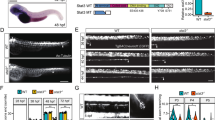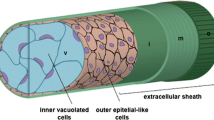Abstract
Overexpression of a lefty orthologue, Ci-lefty, caused a failure of neural tube closure in the protochordate ascidian Ciona intestinalis. The body bent dorsally, and anterior–posterior elongation was inhibited. A similar phenotype was observed in embryos treated with SB431542, an inhibitor of Nodal receptors, suggesting that Ci-Lefty antagonized Nodal signaling as reported in other deuterostome species. Overexpression of Ci-nodal also resulted in a similar phenotype, suggesting that a correct quantity and/or a spatial restriction of Nodal signaling are important for the neural tube to form. In addition to known Ci-Nodal target genes, orthologues of Zic (Ci-ZicL) and cdx (Ci-cdx) were activated by Ci-Nodal. Expression of a dominant negative Ci-cdx caused defects in neural tube formation similar to those obtained on treatment with SB431542 or overexpression of Ci-lefty. A regulatory cascade composed of Ci-Nodal, Ci-ZicL, and Ci-Cdx may play an important role in neural tube formation in the Ciona embryo.





Similar content being viewed by others
References
Anno C, Satou A, Fujiwara S (2006) Transcriptional regulation of ZicL in the Ciona intestinalis embryo. Dev Genes Evol 216:597–605
Boorman CJ, Shimeld SM (2002) The evolution of left–right asymmetry in chordates. Bioessays 24:1004–1011
Chea HK, Wright C, Swalla BJ (2005) Nodal signaling and the evolution of deuterostome gastrulation. Dev Dyn 234:269–278
Corbo JC, Erives A, Di Gregorio A, Chang A, Levine M (1997a) Dorsoventral patterning of the vertebrate neural tube is conserved in a protochordate. Development 124:2335–2344
Corbo JC, Levine M, Zeller RW (1997b) Characterization of a notochord-specific enhancer from the Brachyury promoter region of the ascidian, Ciona intestinalis. Development 124:589–602
Dehal P, Satou Y, Campbell RK, Chapman J, Degnan B, De Tomaso A, Davidson B, Di Gregorio A, Gelpke M, Goodstein DM, Harafuji N, Hastings KEM, Ho I, Hotta K, Huang W, Kawashima T, Lemaire P, Martinez D, Meinertzhagen IA, Necula S, Nonaka M, Putnam N, Rash S, Saiga H, Satake M, Terry A, Yamada L, Wang H-G, Awazu S, Azumi K, Boore J, Branno M, Chin-bow S, De Santis R, Doyle S, Francino P, Keys DN, Haga S, Hayashi H, Hino K, Imai KS, Inaba K, Kano S, Kobayashi K, Kobayashi M, Lee B-I, Makabe KW, Manohar C, Matassi G, Medina M, Mochizuki Y, Mount S, Morishita T, Miura S, Nakayama A, Nishizaka S, Nomoto H, Ohta F, Oishi K, Rigoutsos I, Sano M, Sasaki A, Sasakura Y, Shoguchi E, Shin-i T, Spagnuolo A, Stainier D, Suzuki MM, Tassy O, Takatori N, Tokuoka M, Yagi K, Yoshizaki F, Wada S, Zhang C, Hyatt PD, Larimer F, Detter C, Doggett N, Glavina T, Hawkins T, Richardson P, Lucas S, Kohara Y, Levine M, Satoh N, Rokhsar DS (2002) The draft genome of Ciona intestinalis: insights into chordate and vertebrate origins. Science 298:2157–2167
Duboc V, Röttinger E, Besnardeau L, Lepage T (2004) Nodal and BMP2/4 signaling organizes the oral–aboral axis of the sea urchin embryo. Dev Cell 6:397–410
Duboc V, Röttinger E, Lapraz F, Besnardeau L, Lepage T (2005) Left–right asymmetry in the sea urchin embryo is regulated by Nodal signaling on the right side. Dev Cell 9:147–158
Epstein M, Pillemer G, Yelin R, Yisraeli JK, Fainsod A (1997) Patterning of the embryo along the anterior–posterior axis: the role of the caudal genes. Development 124:3805–3814
Felsenstein J (1981) Evolutionary trees from DNA sequences: a maximum likelihood approach. J Mol Evol 17:368–376
Flowers VL, Courteau GR, Poustka AJ, Weng W, Venuti JM (2004) Nodal/activin signaling establishes oral–aboral polarity in the early sea urchin embryo. Dev Dyn 231:727–740
Fujiwara S, Maeda Y, Shin-i T, Kohara Y, Takatori N, Satou Y, Satoh N (2002) Gene expression profiles in Ciona intestinalis cleavage-stage embryos. Mech Dev 112:115–127
Hino K, Satou Y, Yagi K, Satoh N (2003) A genomewide survey of developmentally relevant genes in Ciona intestinalis. VI. Genes for Wnt, TGFβ, Hedgehog and JAK/STAT signaling pathways. Dev Genes Evol 213:264–272
Hudson C, Yasuo H (2005) Patterning across the ascidian neural plate by lateral Nodal signalling sources. Development 132:1199–1210
Hudson C, Yasuo H (2006) A signalling relay involving Nodal and Delta ligands acts during secondary notochord induction in Ciona embryos. Development 133:2855–2864
Hudson C, Darras S, Caillol D, Yasuo H, Lemaire P (2003) A conserved role for the MEK signalling pathway in neural tissue specification and posteriorisation in the invertebrate chordate, the ascidian Ciona intestinalis. Development 130:147–159
Imai KS (2003) Isolation and characterization of β-catenin downstream genes in early embryos of the ascidian Ciona savignyi. Differentiation 71:346–360
Imai KS, Satoh N, Satou Y (2002) An essential role of a FoxD gene in notochord induction in Ciona embryos. Development 129:3441–3453
Imai KS, Hino K, Yagi K, Satoh N, Satou Y (2004) Gene expression profiles of transcription factors and signaling molecules in the ascidian embryo: towards a comprehensive understanding of gene networks. Development 131:4047–4058
Imai KS, Levine M, Satoh N, Satou Y (2006) Regulatory blueprint for a chordate embryo. Science 312:1183–1187
Inman GJ, Nicolas FJ, Callahan JF, Harling JD, Gaster LM, Reith AD, Laping NJ, Hill CS (2002) SB-431542 is a potent and specific inhibitor of transforming growth factor-β superfamily type I activin receptor-like kinase (ALK) receptors ALK4, ALK5, and ALK7. Mol Pharmacol 62:65–74
Isaacs HV, Pownall ME, Slack JMW (1998) Regulation of Hox gene expression and posterior development by the Xenopus caudal homologue Xcad3. EMBO J 17:3413–3427
Jaynes JB, O’Farrell PH (1991) Active repression of transcription by the engrailed homeodomain protein. EMBO J 10:1427–1433
Juan H, Hamada H (2001) Roles of nodal-lefty regulatory loops in embryonic patterning of vertebrates. Genes Cells 6:923–930
Katsuyama Y, Sato Y, Wada S, Saiga H (1999) Ascidian tail formation requires caudal function. Dev Biol 213:257–268
Kingsley DM (1994) The TGF-β superfamily: new members, new receptors, new genetic tests of function in different organisms. Genes Dev 8:133–146
Lohnes D (2003) The Cdx1 homeodomain protein: an integrator of posterior signaling in the mouse. Bioessays 25:971–980
Macdonald PM, Struhl G (1986) A molecular gradient in early Drosophila embryos and its role in specifying the body pattern. Nature 324:537–545
Marom K, Shapira E, Fainsod A (1997) The chicken caudal genes establish an anterior–posterior gradient by partially overlapping temporal and spatial patterns of expression. Mech Dev 64:41–52
Morokuma J, Ueno M, Kawanishi H, Saiga H, Nishida H (2002) HrNodal, the ascidian nodal-related gene, is expressed in the left side of the epidermis, and lies upstream of HrPitx. Dev Genes Evol 212:439–446
Nagatomo K, Ishibashi T, Satou Y, Satoh N, Fujiwara S (2003) Retinoic acid affects gene expression and morphogenesis without upregulating the retinoic acid receptor in the ascidian Ciona intestinalis. Mech Dev 120:363–372
Onuma Y, Takahashi S, Yokota C, Asashima M (2002) Multiple nodal-related genes act coordinately in Xenopus embryogenesis. Dev Biol 241:94–105
Osada S, Wright CVE (1999) Xenopus nodal-related signaling is essential for mesendodermal patterning during early embryogenesis. Development 126:3229–3240
Pasini A, Amiel A, Rothbächer U, Roure A, Lemaire P, Darras S (2006) Formation of the ascidian epidermal sensory neurons: insights into the origin of the chordate peripheral nervous system. PLOS Biol 4:1173–1186
Satou Y, Takatori N, Fujiwara S, Nishikata T, Saiga H, Kusakabe T, Shin-i T, Kohara Y, Satoh N (2002a) Ciona intestinalis cDNA projects: expressed sequence tag analyses and gene expression profiles during embryogenesis. Gene 287:83–96
Satou Y, Yamada L, Mochizuki Y, Takatori N, Kawashima T, Sasaki A, Hamaguchi M, Awazu S, Yagi K, Sasakura Y, Nakayama A, Ishikawa H, Inaba K, Satoh N (2002b) A cDNA resource from the basal chordate Ciona intestinalis. Genesis 33:153–154
Schier AF, Shen MM (2000) Nodal signaling in vertebrate development. Nature 403:385–389
Thisse C, Thisse B (1999) Antivin, a novel and divergent member of the TGFβ superfamily, negatively regulates mesoderm induction. Development 126:229–240
van den Akker E, Forlani S, Chawengsaksophak K, de Graaff W, Beck F, Meyer BI, Deschamps J (2002) Cdx1 and Cdx2 have overlapping functions in anteroposterior patterning and posterior axis elongation. Development 129:2181–2193
Wallingford JB, Harland RM (2001) Xenopus Dishevelled signaling regulates both neural and mesodermal convergent extension: parallel forces elongating the body axis. Development 128:2581–2592
Whitman M (2001) Nodal signaling in early vertebrate embryos: themes and variations. Dev Cell 1:605–617
Yagi K, Satou Y, Satoh N (2004) A zinc finger transcription factor, ZicL, is a direct activator of Brachyury in the notochord specification of Ciona intestinalis. Development 131:1279–1288
Yokota C, Kofron M, Zuck M, Houston DW, Isaacs H, Asashima M, Wylie CC, Heasman J (2003) A novel role for a nodal-related protein; Xnr3 regulates convergent extension movements via the FGF receptor. Development 130:2199–2212
Acknowledgements
We thank Nori Satoh and Kazuko Hirayama at Kyoto University and Zenji Imoto at the Usa Marine Biological Institute of Kochi University for providing animals. We thank Hidetoshi Saiga at Tokyo Metropolitan University for kindly providing the plasmid containing EnR. We are also grateful to You Katsuyama for valuable advice. This work was supported by MEXT Japan. K. M. was supported by the Sasakawa Scientific Research Grant from The Japan Science Society.
Author information
Authors and Affiliations
Corresponding author
Additional information
Communicated by: N. Satoh
Electronic supplementary material
Below is the image is a link to a high resolution version
Supplementary Fig. S1
Characterization of a lefty/antivin orthologue in C. intestinalis. (a) The amino acid sequence predicted from the Ci-lefty cDNA is aligned with other Lefty protein sequences obtained from mouse (m), zebrafish (z), and the sea urchin Paracentrotus lividus (Pl). The putative signal peptide region is indicated by a bar. Cysteine residues conserved among Lefty proteins are shown by green shade. An arrowhead indicates the position where cysteine is conserved in other TGF-β superfamily proteins but not in Lefty proteins. Putative protein product of Ci-lefty consists of 385 amino acids. A characteristic configuration of seven cysteine residues, called a cysteine knot, is conserved among TGF-β superfamily members (Kingsley 1994). Among the family, only the Lefty/Antivin group lacks the fourth cysteine residue (Thisse and Thisse 1999; Juan and Hamada 2001). A predicted amino acid sequence of Ci-Lefty showed the Lefty/Antivin-type cysteine knot. The N-terminal signal peptide sequence was observed in the Lefty proteins, including Ci-Lefty. (b) A phylogenetic tree of TGF-β superfamily proteins constructed by the maximum likelihood method (Felsenstein 1981), using full-length amino acid sequences. Zebrafish and mouse TGF-β proteins were defined as an outgroup. Ci, C. intestinalis; m, mouse; Pl, P. lividus; z, zebrafish. Orthologues of lefty formed a monophyletic cluster. Within the cluster, the branching pattern was consistent with widely accepted phylogenetic relationships of deuterostome groups. Paralogous subgroups in vertebrates (e.g. Lefty1 and Lefty2 in the mouse) diverged within the vertebrate clade. (GIF 43 kb)
Rights and permissions
About this article
Cite this article
Mita, K., Fujiwara, S. Nodal regulates neural tube formation in the Ciona intestinalis embryo. Dev Genes Evol 217, 593–601 (2007). https://doi.org/10.1007/s00427-007-0168-x
Received:
Accepted:
Published:
Issue Date:
DOI: https://doi.org/10.1007/s00427-007-0168-x




